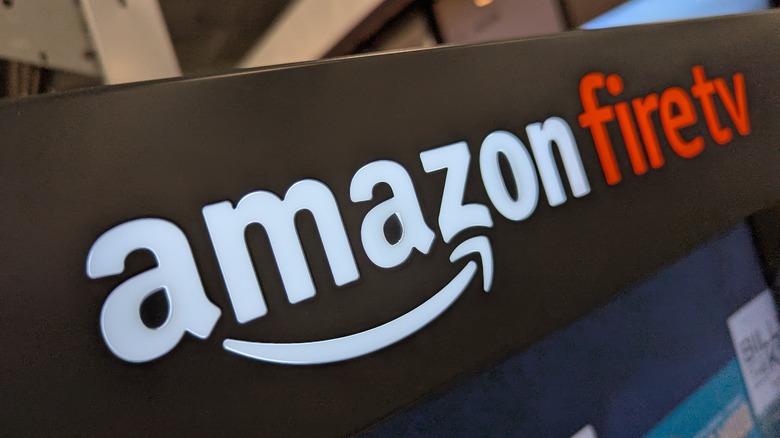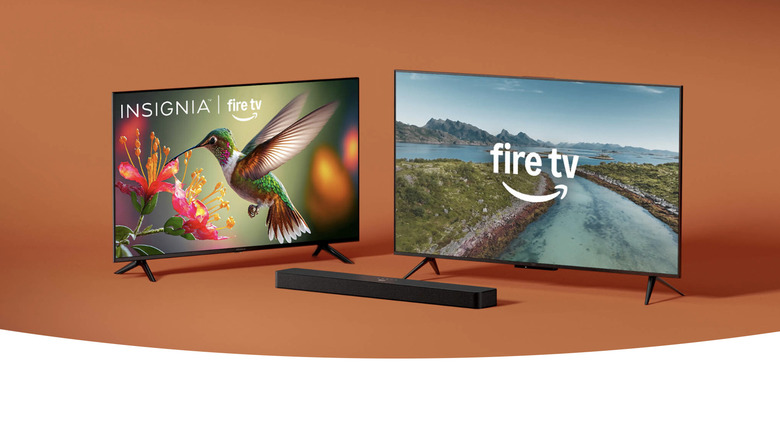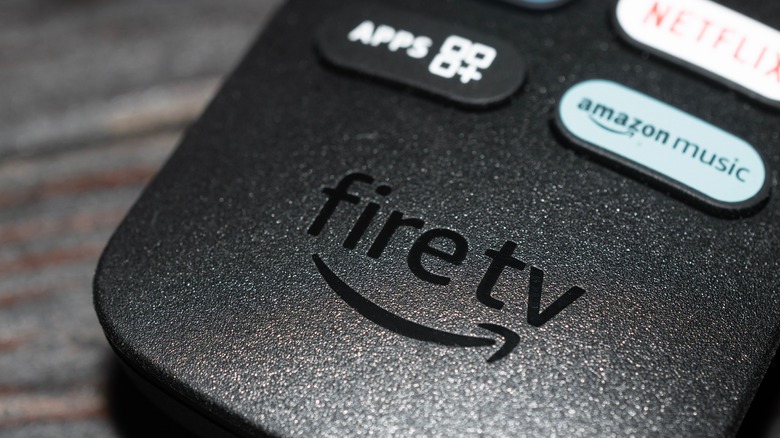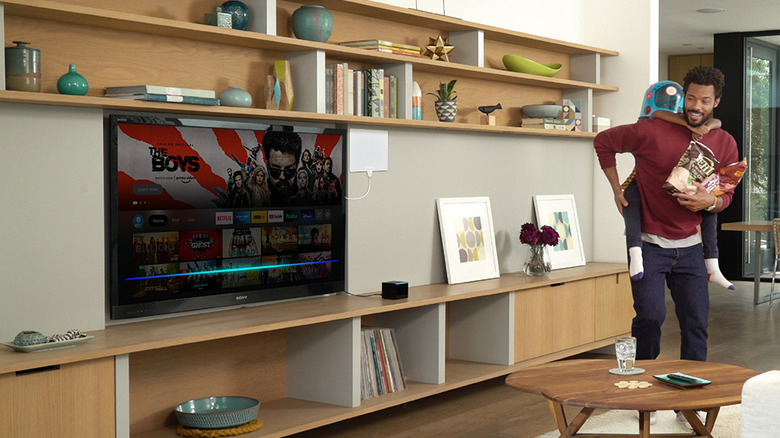Thinking About Buying A Cheap Amazon Fire TV? Here Are 4 Things You Need To Know
We may receive a commission on purchases made from links.
If you've been shopping around for a new cheap TV, we're willing to bet you've seen the "Fire TV" label come up in your research and browsing sessions at your local electronics store. Fire TV refers to Amazon's in-house operating system and smart platform for web-connected television sets and Fire TV Stick streaming devices.
Generally speaking, Fire TV-powered sets deliver great picture quality and a robust set of smart features at a relatively friendly cost. You'll even be able to use Alexa, Amazon's voice assistant, to search for movies and shows, change channels, dim your smart lights, and more.
But that's not all there is to know about the Fire TV moniker. Depending on how you're going to use your new TV, one set could give you a very different picture and performance experience than another. On the surface, it sounds confusing, but that's why we put together this list of the four things you need to know when buying an Amazon Fire TV.
The Fire TV name is licensed to several TV brands
This might be one of the most confusing aspects of Amazon's TV footprint. The "Fire TV" moniker isn't just one type of TV; it's actually an operating system and smart platform that Amazon licenses to a few different manufacturers. In addition to Amazon making its own first-party Fire TVs, some of the most popular TV brands, such as TCL, Hisense, and Toshiba, also utilize Amazon's platform.
While you'll be able to enjoy a number of the same core features — like Alexa-powered voice controls, streaming apps, etc. — across all Fire TV products, picture quality can vary widely from one brand and model to the next. This is because Amazon simply licenses the Fire TV operating system to third-party manufacturers, each of which uses its own image processing methods and other in-house tools to put a picture on your screen. One thing to keep in mind: If you're looking for the absolute best price on a Fire TV, and couldn't care less if it was released by Amazon, third-party licensed sets tend to be some of the least expensive options on the market.
Fire TV can game, but look closely at the specs
When it comes to gaming performance, most Amazon Fire TVs are engineered to give you a phenomenal console experience, whether you're hooking up a Nintendo Switch or a PlayStation 5 Pro. But if you're looking to get the best gaming experience possible, you'll want to be on the lookout for certain specs. Of chief importance is a native refresh rate of 120Hz or better. This means the television is able to draw up to 120 frames per second, which bodes well for fast-moving content like FPS (first-person shooter) titles, as well as sports and action movies.
Now, certain manufacturers can be a little tricky when it comes to advertising refresh rates. You may see descriptors like "MotionPlus 240" or "MotionMax 480", which don't reflect the TV's native refresh rate — it's an approximation of the motion performance after the manufacturer's digital motion enhancements are applied. Sometimes, you'll have to dig into the tech specs of a TV you're interested in to find out what its true refresh rate is.
Right now, none of Amazon's first-party Fire TVs support anything more than 60Hz, except for the Amazon Fire TV Omni Mini-LED QLED, which supports up to a 144Hz refresh rate. Console and PC gamers should also be on the lookout for VRR (variable refresh rate) and ALLM (auto low latency mode), two features that allow a Fire TV to cut down on screen tearing and input lag, resulting in smoother-performing gameplay. Do keep in mind that many 60Hz refresh rate TVs can still deliver a great gaming experience, especially if the set you're interested in has a built-in game mode, VRR, or ALLM capabilities.
You won't be able to get away from ads
No matter what type of streaming device or smart TV you decide to purchase, you're going to have to deal with interface advertisements. It just so happens that Amazon's Fire TV OS tends to be a bit more aggressive in its placement of these adverts. You'll find them everywhere on Fire TV; from inline banners to overriding screensavers with full-screen ads, Amazon leaves no stone unturned when marketing its movies, shows, products, and services.
While you'll be able to dip into Amazon's Advertising Privacy and Preferences page to choose whether or not you'll see interest-based ads, there isn't an option to disable ads entirely. Should you decide to disable personalized ads, you'll still be faced with whatever Amazon and its third-party affiliates decide to showcase.
It's hard to say how much of an impact Amazon ads have on the overall performance of the Fire TV platform, but it's possible that homes with weaker network connections may end up dealing with sluggish Fire TV performance from time to time. So, it stands to reason that interactive UI ads with baked-in images, animations, and additional scripts to run will hinder more than help your Fire TV experience.
Hands-free Alexa is limited to higher-end sets
All Amazon Fire TVs on the market have the Alexa voice assistant built in, whether it's a first-party Amazon set or a brand like Toshiba or Hisense. You can use the digital companion to search for movies, shows, apps, and other content using voice commands. You'll also be able to control certain smart home devices from the comfort of the living room couch, and can even pull up live video feeds from compatible security cams right on your TV screen.
Some Fire TV models have slightly more advanced Alexa features. For example, the 2024 Amazon Fire TV Omni Mini-LED QLED has hands-free Alexa controls. This means you'll be able to freely speak voice commands without first pushing a button on the remote to activate a microphone. You can still use Alexa on a more budget-friendly Amazon Fire TV; you'll just need to press the Alexa button on the TV remote whenever you want to activate the voice assistant.




